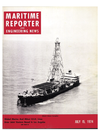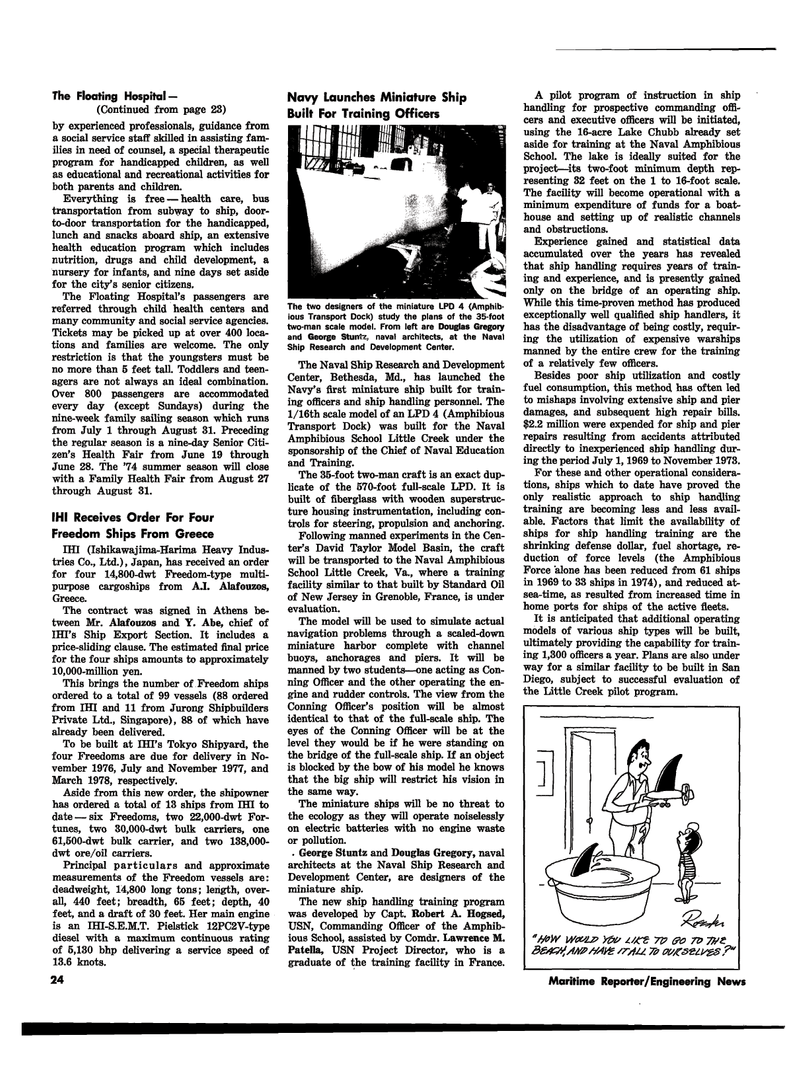
Page 22: of Maritime Reporter Magazine (July 15, 1974)
Read this page in Pdf, Flash or Html5 edition of July 15, 1974 Maritime Reporter Magazine
The Floating Hospital — (Continued from page 23) by experienced professionals, guidance from a social service staff skilled in assisting fam- ilies in need of counsel, a special therapeutic program for handicapped children, as well as educational and recreational activities for both parents and children.
Everything is free — health care, bus transportation from subway to ship, door- to-door transportation for the handicapped, lunch and snacks aboard ship, an extensive health education program which includes nutrition, drugs and child development, a nursery for infants, and nine days set aside for the city's senior citizens.
The Floating Hospital's passengers are referred through child health centers and many community and social service agencies.
Tickets may be picked up at over 400 loca- tions and families are welcome. The only restriction is that the youngsters must be no more than 5 feet tall. Toddlers and teen- agers are not always an ideal combination.
Over 800 passengers are accommodated every day (except Sundays) during the nine-week family sailing season which runs from July 1 through August 31. Preceding the regular season is a nine-day Senior Citi- zen's Health Fair from June 19 through
June 28. The '74 summer season will close with a Family Health Fair from August 27 through August 31.
IHI Receives Order For Four
Freedom Ships From Greece
IHI (Ishikawajima-Harima Heavy Indus- tries Co., Ltd.), Japan, has received an order for four 14,800-dwt Freedom-type multi- purpose cargoships from A.I. Alafouzos,
Greece.
The contract was signed in Athens be- tween Mr. Alafouzos and Y. Abe, chief of
IHI's Ship Export Section. It includes a price-sliding clause. The estimated final price for the four ships amounts to approximately 10,000-million yen.
This brings the number of Freedom ships ordered to a total of 99 vessels (88 ordered from IHI and 11 from Jurong Shipbuilders
Private Ltd., Singapore), 88 of which have already been delivered.
To be built at IHI's Tokyo Shipyard, the four Freedoms are due for delivery in No- vember 1976, July and November 1977, and
March 1978, respectively.
Aside from this new order, the shipowner has ordered a total of 13 ships from IHI to date — six Freedoms, two 22,000-dwt For- tunes, two 30,000-dwt bulk carriers, one 61,500-dwt bulk carrier, and two 138,000- dwt ore/oil carriers.
Principal particulars and approximate measurements of the Freedom vessels are: deadweight, 14,800 long tons; length, over- all, 440 feet; breadth, 65 feet; depth, 40 feet, and a draft of 30 feet. Her main engine is an IHI-S.E.M.T. Pielstick 12PC2V-type diesel with a maximum continuous rating of 5,130 bhp delivering a service speed of 13.6 knots.
Navy Launches Miniature Ship
Built For Training Officers
The two designers of the miniature LPD 4 (Amphib- ious Transport Dock) study the plans of the 35-foot two-man scale model. From left are Douglas Gregory and George Stunts, naval architects, at the Naval
Ship Research and Development Center.
The Naval Ship Research and Development
Center, Bethesda, Md., has launched the
Navy's first miniature ship built for train- ing officers and ship handling personnel. The l/16th scale model of an LPD 4 (Amphibious
Transport Dock) was built for the Naval
Amphibious School Little Creek under the sponsorship of the Chief of Naval Education and Training.
The 35-foot two-man craft is an exact dup- licate of the 570-foot full-scale LPD. It is built of fiberglass with wooden superstruc- ture housing instrumentation, including con- trols for steering, propulsion and anchoring.
Following manned experiments in the Cen- ter's David Taylor Model Basin, the craft will be transported to the Naval Amphibious
School Little Creek, Va., where a training facility similar to that built by Standard Oil of New Jersey in Grenoble, France, is under evaluation.
The model will be used to simulate actual navigation problems through a scaled-down miniature harbor complete with channel buoys, anchorages and piers. It will be manned by two students—one acting as Con- ning Officer and the other operating the en- gine and rudder controls. The view from the
Conning Officer's position will be almost identical to that of the full-scale ship. The eyes of the Conning Officer will be at the level they would be if he were standing on the bridge of the full-scale ship. If an object is blocked by the bow of his model he knows that the big ship will restrict his vision in the same way.
The miniature ships will be no threat to the ecology as they will operate noiselessly on electric batteries with no engine waste or pollution. . George Stuntz and Douglas Gregory, naval architects at the Naval Ship Research and
Development Center, are designers of the miniature ship.
The new ship handling training program was developed by Capt. Robert A. Hogsed,
USN, Commanding Officer of the Amphib- ious School, assisted by Comdr. Lawrence M.
Patella, USN Project Director, who is a graduate of the training facility in France.
A pilot program of instruction in ship handling for prospective commanding offi- cers and executive officers will be initiated, using the 16-acre Lake Chubb already set aside for training at the Naval Amphibious
School. The lake is ideally suited for the project—its two-foot minimum depth rep- resenting 32 feet on the 1 to 16-foot scale.
The facility will become operational with a minimum expenditure of funds for a boat- house and setting up of realistic channels and obstructions.
Experience gained and statistical data accumulated over the years has revealed that ship handling requires years of train- ing and experience, and is presently gained only on the bridge of an operating ship.
While this time-proven method has produced exceptionally well qualified ship handlers, it has the disadvantage of being costly, requir- ing the utilization of expensive warships manned by the entire crew for the training of a relatively few officers.
Besides poor ship utilization and costly fuel consumption, this method has often led to mishaps involving extensive ship and pier damages, and subsequent high repair bills. $2.2 million were expended for ship and pier repairs resulting from accidents attributed directly to inexperienced ship handling dur- ing the period July 1,1969 to November 1973.
For these and other operational considera- tions, ships which to date have proved the only realistic approach to ship handling training are becoming less and less avail- able. Factors that limit the availability of ships for ship handling training are the shrinking defense dollar, fuel shortage, re- duction of force levels (the Amphibious
Force alone has been reduced from 61 ships in 1969 to 33 ships in 1974), and reduced at- sea-time, as resulted from increased time in home ports for ships of the active fleets.
It is anticipated that additional operating models of various ship types will be built, ultimately providing the capability for train- ing 1,300 officers a year. Plans are also under way for a similar facility to be built in San
Diego, subject to successful evaluation of the Little Creek pilot program. "£/oW WCVLZ? V&£/ Tp ffo 7V 7h>£ /r/fu 7o pmswzs? 24 Maritime Reporter/Engineering News

 21
21

 23
23
